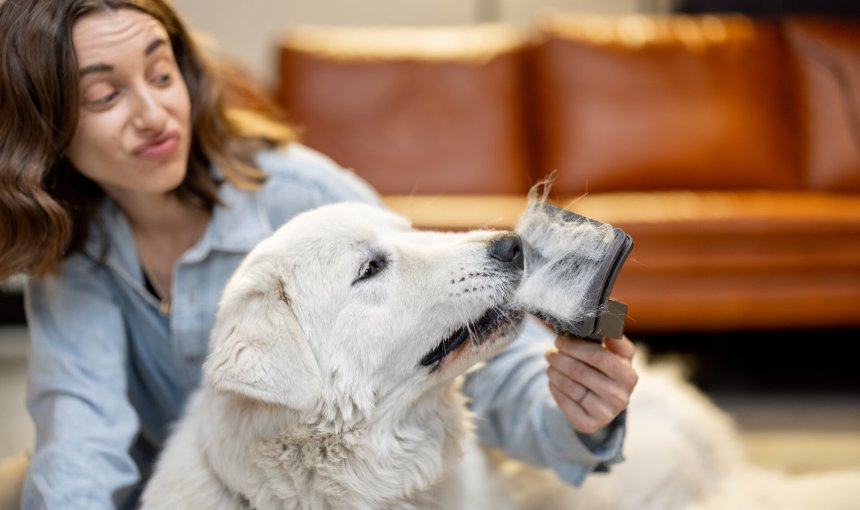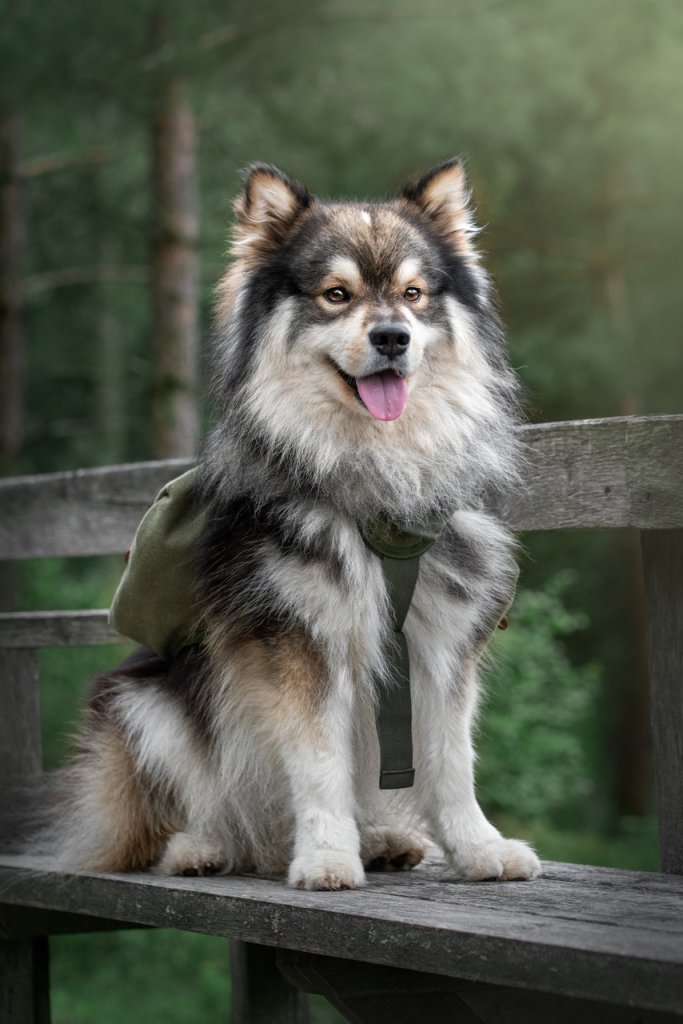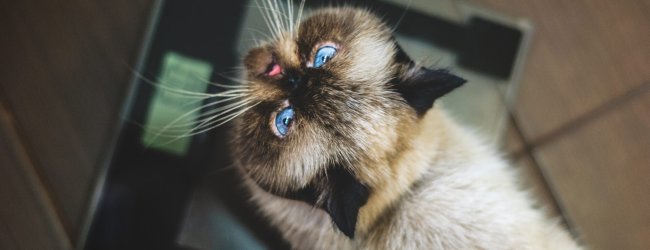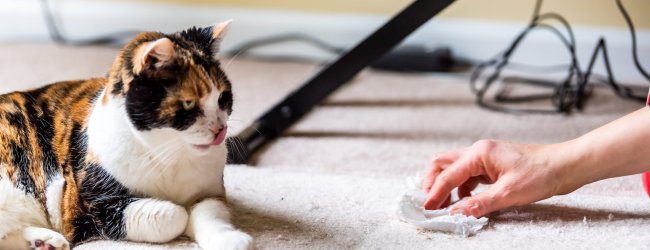 Approved by Dr. Dwight Alleyne, DVM
Approved by Dr. Dwight Alleyne, DVM Dog Losing Hair? 5 Reasons Why & What To Do
If you're finding yourself vacuuming a new carpet of dog hair every so often...it might not just be seasonal shedding. Here are 5 key reasons why you've got a dog losing hair - and how to address them.

While a bit of shedding is totally normal, a dog losing hair on a consistent basis may be a cause for concern. At least one of the reasons may include alopecia in dogs – and it’s important you figure out the reason why it’s happening and take action as soon as you spot it. So if you’ve got an apartment filled to the brim with dog hair or your buddy’s been scratching themselves raw, keep reading.

Always know your buddy is healthy & safe
Read moreWhy is my dog losing hair?
Now before we all panic, losing some amount of fur is 100% normal for your dog. (Especially if they shed around specific times of the year.) In fact, your dog’s breed might play a role as well, since it affects their likelihood of growing an undercoat that might end up shedding all over your apartment around spring.
Other reasons could include your dog being in heat1 – meaning they might release specific hormones that can speed up the process of your dog losing hair. Or, if you’ve gotten your dog neutered, they might actually shed less.2
So here are some of the less concerning reasons behind a dog losing fur – and why they happen.
Your dog’s just growing up
Dogs tend to lose their fur for the first time as puppies. Aka, when they lose their original baby coat. (You know, the soft, cuddly one that just feels like heaven when you hug them – and also leaves a bit of a mess on your clothes.)
After losing this baby coat, your little buddy will grow a new type of fur – i.e., their “adult fur.” This process can stretch in time from a few weeks to a few months.
💡So it’s wise to get your dog used to brushing and grooming as a puppy. This way, they won’t be afraid of the sounds or feel of instruments like clippers – and they’ll be more likely to cooperate in the future.
Read more: 5 Easy Dog Grooming Tips You Can Do At Home: The Ultimate Guide For Dog Parents
It’s seasonal shedding time
Around twice a year, depending on their breed and age, almost every dog goes through the process of losing fur for 6-8 weeks. Changes in daylight and temperature send signals to your dog’s body for when it’s time for a thinner or thicker coat.3
- Autumn to winter. Here, your dog might lose fur to create room for their new, thick winter coat.
- Winter to spring. Here, you might find your dog losing hair as they lose their winter coat.
⚠️ Which is actually why it’s generally a terrible idea to shave your dog’s fur when the weather gets hot. Your dog’s body can naturally regulate its own temperature, so make sure not to shave them – no matter how warm it gets outdoors.
Your dog’s breed just sheds a bit more than others in general
Depending on your dog’s breed, they might just shed a bit more than others due to how thick their coats get. Here are a couple:
- The Retriever family
- Newfoundlands
- Pekingese
- Chow chows
- Akitas
- The Husky family
- Corgis
- The Shepherd family
- Malamutes
- Finnish Lapphunds (pictured below)

In most cases, these dogs have thick undercoats that help keep them warm and toasty throughout the colder months.
On the other hand, dogs like Poodles, Terriers, and Dachshunds tend to have lighter seasonal shedding, year-round.
Why is my dog losing hair in patches and scabs?
Now if you’re finding your dog losing hair in bald spots or patches, you may be dealing with a case of canine alopecia. Meaning it’s time to find out the root cause – and drop by your vet as soon as possible. Alopecia in dogs is different from seasonal shedding, which tends to be hair loss across your dog’s body. You might notice your dog scratching more than usual – or excessively. (Though at times, they might end up losing fur with no scratching at all.)4
With time, this may lead to:
- Reddened, inflamed skin
- Red spots (called papules)
- Pustules
- Hives
- Oozing and/or bleeding
- Open wounds from excessive scratching
If you notice any of these signs, drop by your vet immediately to find out what’s causing it. Because the reasons your dog might be losing hair in patches and scabs could include:
An infection
Your dog’s environment is one of the key places they might pick up an infection. Including where they’re wandering outdoors, or if it’s too hot, moist, or dirty.5 So if you’ve got a dog that enjoys their outdoor time, it’s possible they might come into contact with critters like:
- Fleas
- Ticks
- Mites (which can also cause mange)
- Bacteria
- Fungi
- Insect bites and stings, including from mosquitoes and spiders
💡So if you’ve got a spotless indoor space, but your dog is an outdoor adventurer, it makes sense to keep track of their favorite hangout spots. Which might include:
- Your neighbors’ backyards (and their pets, whose fur may also have their own share of pests)
- The nearby patch of flea-riddled woodland
- Your local park, which may include both pests – and other pets who might pass these on to your dog
An allergy
Your dog might also be losing hair in patches due to an allergy. Including from:
- Inhalation, like if they come in contact with pollen or dander
- Contact, especially from other pets and wild animals
- Insects, especially if they’re bitten or stung
In some rare cases, your dog might end up itching excessively from a food allergy. (Including other signs like diarrhea and vomiting.)6 Which is why, again, it makes sense to track where your dog’s off wandering – so you know for sure what they’re coming in contact with, plus if they’re eating something they really shouldn’t.
Other causes
Aside from infections and allergies, here are some other reasons behind alopecia in dogs:
- Your dog’s genetic history, which may include atopy or a heightened sensitivity to developing allergies.
- Nutrition, especially if they’re deprived of specific vitamins
- Chemical exposure
- Burns
- Anxiety and/or stress
- An autoimmune disorder
- An endocrine disorder, including hypothyroidism
- Cancer
In some cases, your dog might also lose a patch of fur around a site they’ve been vaccinated. While it should normally be temporary, get in touch with your vet if it persists and the hair doesn’t grow back in a few weeks.
How your vet might diagnose alopecia in dogs
Now if you’ve headed to your vet, they’ll usually begin by thoroughly examining your dog to find out the root cause of their hair loss. (As well as scout out any visible pests like ticks or mites.)
Besides, make sure you go prepared with your dog’s medical history – including their:
- Age
- Breed
- Diet
- Any existing medical conditions you’re aware of
- Their outdoor habits, including whether they have a “job” – like herding cattle
- Their environment, including what they’re exposed to – like woodland, ponds, or other animals
- How many other pets you have at home
Your vet might also recommend the following tests to figure out what’s causing their hair loss:
- Skin scrapes to look out for signs of mange or a bacterial culture
- Black light to help them look out for fungal cultures
- An ear smear, which can help detect bacteria, yeast, and mites
- A skin test to check for allergies
- A blood test to check for endocrinal diseases
- A stool sample to check for parasites
In more serious cases, your dog might also have to undergo a biopsy to check for more serious health conditions like cancer.
What your vet might recommend to treat alopecia in dogs
Depending on what’s causing your dog to lose fur, your vet might recommend:
- A change in your dog’s diet, especially if it’s triggered by a food allergy. These might include hypoallergenic dog foods, which are less likely to trigger a flareup.
- Specific medications to help reduce itching and get rid of any infections.
- Medically-approved products, including medicated shampoos.
Avoid using products designed for humans on your dog – no matter how badly they’re itching. In most cases, these products contain ingredients toxic to dogs and may even be fatal in some cases!
How to prevent your dog from losing hair – much in advance
With a few, simple, practical steps – like routine vet visits – you can stay on top of your dog’s health before it has a chance to worsen. Specifically, if you’re dealing with a dog losing hair, you could:
Make regular grooming a priority
With regular brushing and bathtime, you can prevent your dog’s fur from matting and tangling. (All factors that make it easy for pests to find a new home.) This can also help you pick out scabs and lesions before your dog has a chance to scratch them even further and cause open wounds in the process, which can also get infected – worsening the problem.
Figure out if something’s stressing out your dog
A change in routine can majorly stress out your dog – including:
- Shifting apartments, cities, states, or even countries
- A new pet (or baby) coming home
- Grief, including losing a loved one (or if someone they’re used to moves out, on, or away)
- A change in your schedule, like if you’ve switched to a night shift and aren’t around at the “usual” times
- A change in habits, like if they’re not allowed to go outside anymore like they’re used to
In these cases, your dog’s stress (and shedding) may be temporary. But make sure to spend some extra quality time with them, so that they feel more secure and reassured. If you’re away from home for long hours, make sure to leave them an enriched environment full of toys and treats to keep them happy and busy.
Read more:
- How To Leave Your Dog Home Alone Without Feeling Guilty
- 13 Fun Games For Dogs (For When You’re Cooped Up Indoors)
Clean up your indoor & outdoor space
Now it’s difficult to pinpoint what exactly might be triggering your dog’s hair loss. But the environment they spend most of their time in can make a world of a difference. So make sure you’re cleaning your indoor space regularly to prevent any buildup of dust, dander, and other pests. (Yes, even your spotless living room is full of them – especially if you’ve got a dog at home!)
Besides, your backyard could do with a bit of treatment as well. Here are a couple of tips:
- Keep your greenery trimmed, including any grass, trees, or shrubs.
- Use household and yard sprays to treat your entire home and yard. Make sure to use animal-friendly products, since these might be toxic to pets otherwise!
- Consider hiring an exterminator if you have a severe problem.
- Check your dog for any critters – including ticks and mites, which are visible to the human eye – when you’re both back from walks or playtime outdoors.
Pay extra attention to your dog’s food
Besides sticking to any vet-prescribed change in diet, make sure to monitor who’s feeding your dog. Including what they’re eating and whether they’re sneaking out to find some extra “treats.”
Because no matter how much of a good boy or good girl your dog is, there’s very little standing between a food-motivated dog and those extra nibbles. Whether it’s from a neighbor who doesn’t know what’s off-limits for them, one of your kids passing off their veggies to them…or the local garbage dump.
Keep track of where your dog likes to spend most of their time
Whether it’s your backyard, the neighbors’ backyard, the local park, or even the next town – your dog has their favorite spots to hang out, hunt, hide, or just get some alone time.
Which isn’t by itself a problem…until they come home extra itchy from spending time in specific zones – and then proceed to roll around all over your carpets, bed, or even on you. (Spreading around everything they’ve come in contact with.)
💡In times like these, a GPS tracker like Tractive can be a lifesaver. Just switch to your dog’s Heat Map & Location History:

…and get a 24-hour history of where your dog’s been spending all their time. (365 days on a Premium subscription.)
Helping you figure out:
- Exactly which spots around your neighborhood they’ve been hanging out in most
- Where to look first in case your dog goes missing
- Whether there’s a specific zone that makes them especially itchy once they’re back home. (So you can mark it as a No Go zone on your Tractive app – and get an alert if your dog tries entering one.)
All of which can help you better understand your dog’s outdoor habits – and have a more productive conversation with your vet.
So, why is my dog losing hair?
In most cases, a dog losing hair is 100% normal – and even healthy at times. Especially in cases like seasonal shedding, where your dog’s preparing to stay nice and warm for the upcoming colder months. In other cases, it may just be because they’re losing their puppy hair. Or hormonal changes due to being in heat or just having been neutered.
But besides, here are a couple of more concerning reasons your dog might be losing hair:
- An infection, including from critters like ticks, fleas, mites, and other parasites.
- An allergy, from an insect bite, a specific food item, or coming in contact with infectious substances like pollen.
- A host of other medical causes, including nutritional deficiencies, chemical exposure, autoimmune and endocrine disorders.
What can I do about it?
First things first, keep an eye out for these signs of alopecia in dogs – including:
- Excessive scratching
- Reddened, inflamed skin
- Red spots (called papules)
- Pustules
- Hives
- Oozing and/or bleeding
- Open wounds from excessive scratching
Head over to your vet immediately with your dog’s medical history and outdoor wandering habits prepared.
💡 And if you’ve invested in a GPS tracker, you know right away if your dog’s favorite hangout spots might include places they might pick up an allergy, infection, or just something itchy.

Follow your dog anywhere
Get real-time location information, wherever they go. And find out when they try to make an escape, or just when they go somewhere they shouldn’t, with Virtual Fences.
Want a vet’s take on how to prevent your dog from losing hair? Here are a couple of easy tricks from Ultimate Pet Vet:
And if you’ve liked this post, share it with a friend or a loved one – and let’s help build a safer, kinder world for our furry friends together.
Your furry friend’s health and wellbeing means as much as to us as it does to you. So we’ve made it a priority to only share medically-relevant content on our blog.
This post was checked, double-checked, and medically verified by Georgia-based vet, Dr. Dwight Alleyne.

Originally from Long Island, New York, Dr. Alleyne began his career at a no-kill animal shelter before becoming a licensed veterinary technician. He graduated from Cornell University Veterinary College in 2006 and completed an internship at Purdue University. Now practicing in Georgia, Dr. Alleyne specializes in soft tissue surgery and ultrasounds. He also writes pet health articles on his website, “The Animal Doctor Blog” (www.anmldrblog.com).



